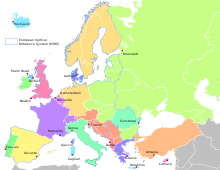



Anordnance datum (OD) is a vertical datum used by an ordnance survey as the basis for deriving altitudes on maps. A spot height may be expressed as above ordnance datum (AOD). Usually mean sea level (MSL) at a particular place is used for the datum.
The First Geodetic Levelling of England and Wales (1840–1860) needed to define a datum plane from which to specify spot heights. At first it was specified as a horizontal plane 100 feet below an arbitrary benchmark on St John's Church, Liverpool. Subsequently, however, it was redefined as mean sea level (MSL). To establish MSL, tidal observations were taken at the Victoria Dock, Liverpool, over a short period in 1844.
By the time of the Second Geodetic Levelling (1912–1921) the importance of stability was better appreciated and so it was decided to use Fundamental Bench Marks (FBMs) installed in solid rock, rather than on buildings as before. To measure average MSL around Great Britain three tide gauges were employed: at Dunbar, Newlyn and Felixstowe. However, it was found that the measured difference between the Dunbar and Newlyn stations was 0.81 feet (0.247m), far larger than could be accounted for by error. The difference was real. Accordingly, it was decided not to use average MSL and fix on one site: MSL Newlyn. Newlyn has certain practical advantages: it is set in granite bedrock, is far from major rivers, and it better represents deep ocean sea levels.
The difference between ODL (Liverpool) and ODN (Newlyn) was found to be 0.13 feet. It took some time for the changed definition — Liverpool to Newlyn — to work through the system: by 1950, some 40% of the lower secondary and tertiary levellings were still using the Liverpool datum. But following the Third Geodetic Levelling, Ordnance Survey maps published since March 1956 give spot heights above the Newlyn datum.[4][5]
Newlyn Tidal Observatory was given grade II listing on 11 December 2018.[6]
Tunnel datum is a datum based on an ordnance datum and used in designing tunnels which pass below sea level.